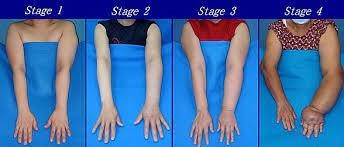A-55-year old male patient is admitted with a massive GI bleed. The patient is at risk for what type of acute kidney injury?
refer to a condition where significant urinary tract obstruction which in severe or long- standing cases can yield to backup of urine into the kidneys
refer to a condition when direct damage to the kidneys causes a sudden loss in kidney function.
refer to a condition in which the kidneys stop functioning due to internal kidney disease.
refer to a condition in which kidney blood flow may become significantly reduced include those in which a significant amount of fluid has been lost.
The Correct Answer is D
Choice A rationale: This refers to postrenal AKI, which is caused by an obstruction in the urinary tract that prevents urine from leaving the body.
Choice B rationale: This refers to AKI in general and is not specific compared to choice D.
Choice C rationale: This refers to intrinsic AKI, which is caused by damage to the kidney tissue or cells from various causes, such as inflammation, infection, toxins, or ischemia.
Choice D rationale: This is correct because it is pre-renal AKI, a condition in which kidney blood flow may become significantly reduced, including cases where a significant amount of fluid has been lost. This situation suggests potential hypovolemia (low blood volume) due to the massive GI bleed, which can lead to reduced kidney blood flow and subsequent acute kidney injury.
Nursing Test Bank
Naxlex Comprehensive Predictor Exams
Related Questions
Correct Answer is A
Explanation
Choice A rationale: Hypoglycemia (blood sugar less than 30 mg/dL) can lead to seizures due to inadequate glucose supply to the brain.
Choice B rationale: Anorexia (loss of appetite) is not directly associated with low blood sugar but can be a symptom of other conditions.
Choice C rationale: Anhidrosis refers to the inability to sweat and is not typically associated with low blood sugar.
Choice D rationale: Bradycardia (slow heart rate) can be a symptom of severe hypoglycemia but is not the primary complication expected at this blood sugar level.
Correct Answer is B
Explanation
Choice A rationale: Her healthcare provider prescribing a calcium channel blocker for hypertension is not directly linked to lymphedema.
Choice B rationale: Sustaining an insect bite to her left arm yesterday - Trauma or injury, such as an insect bite, to the affected limb post-mastectomy can increase the risk of
lymphedema.
Choice C rationale: Losing twenty pounds since the surgery might influence overall health but doesn’t specifically relate to lymphedema.
Choice D rationale: Her hobby of playing classical music on the piano is unrelated to the risk of developing lymphedema.

Whether you are a student looking to ace your exams or a practicing nurse seeking to enhance your expertise , our nursing education contents will empower you with the confidence and competence to make a difference in the lives of patients and become a respected leader in the healthcare field.
Visit Naxlex, invest in your future and unlock endless possibilities with our unparalleled nursing education contents today
Report Wrong Answer on the Current Question
Do you disagree with the answer? If yes, what is your expected answer? Explain.
Kindly be descriptive with the issue you are facing.
